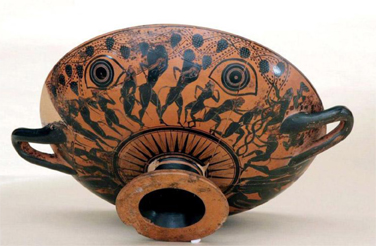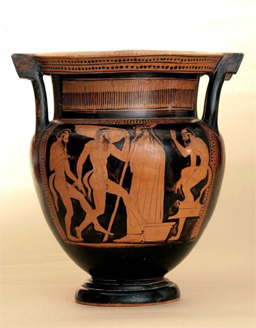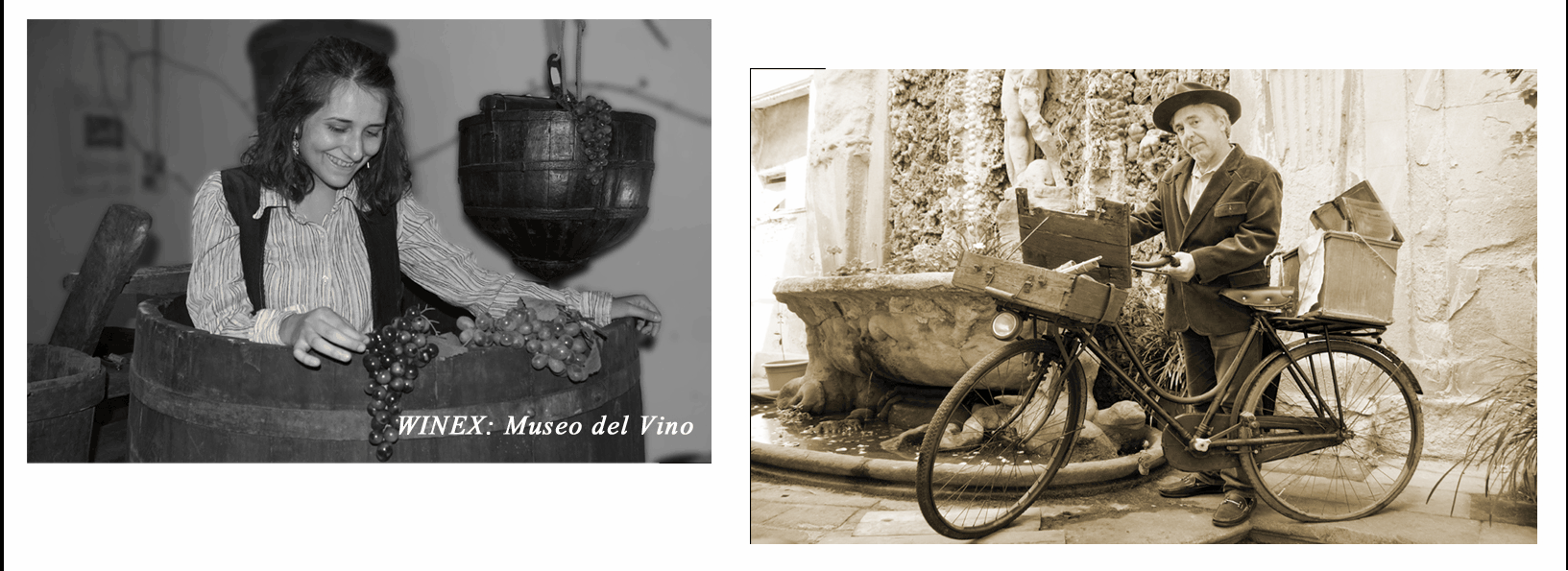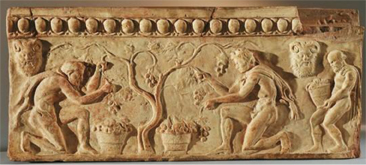La
storia del vino è un po' la storia stessa dell'umanità, testimoniata
dalle fonti scritte e figurative, ma ancor più dai recenti strumenti
dell'investigazione archeologica, dalla biologia molecolare all'analisi
del DNA, che hanno permesso di far risalire ad epoche remote, circa
7.000 anni fa, i primi tentativi di acclimatare la vite eurasiatica nei
luoghi dove hanno avuto origine le civiltà gravitanti sul bacino del
Mediterraneo.
Rimedio curativo, lubrificante sociale, sostanza stupefacente e merce
di scambio, il vino acquisisce ben presto un ruolo centrale nei culti
religiosi, nella farmacopea, nell'economia e nella vita sociale di
molte civiltà antiche; non solo, presso tutti i popoli dell'antichità è
sempre stato ritenuto, insieme all'olio, uno dei simboli più evidenti
della ricchezza.
Già seimila anni fa, i Sumeri simboleggiavano con una foglia di vite
l'esistenza umana ed anche gli Ebrei dell'Antico Testamento, che
attribuivano a Noè la piantagione della prima vigna, consideravano la
vite "uno dei beni più preziosi
dell'uomo"
(1 Re), ed esaltavano il vino (Salmi). Si legge nell'Odissea (Il,
426-432) che la sala della reggia di Itaca, dove erano conservati i
tesori di Ulisse, era... " "che
rallegra il cuore del mortale"ampia,
dove oro e bronzo giacevano a mucchi, e vesti nei cojani, e olio
fragrante in abbondanza: e orci di vino vecchio, dolce da bere,
stavano, pieni di schietta, divina bevanda, disposti in fila lungo la
parete ... ".
Nel mondo greco il vino era ritenuto un dono degli Dei e tutti i miti
sono concordi nell'attribuire a Dioniso, il più giovane figlio
immortale di Zeus, l'introduzione della coltura della vite tra gli
uomini, tanto che Dioniso, il dio del vino, fu oggetto di culto non
solo presso i Greci ma anche in Etruria, dove era identificato con la
divinità agreste Fufiuns e
quindi nel mondo romano, dove era conosciuto come Bacco e ricollegato a
Liber,
antica divinità latina della fertilità.
La pratica della viticoltura vanta origini antichissime: la vite
selvatica eurasiatica è documentata in un'area di circa 6.000 km², dal
Mar Nero all'Anatolia orientale, dalla Siria alla Spagna, passando per
la Grecia e l'Italia. Già nel VI millennio a.C., in un sito neolitico
dell'Iran nord-occidentale, Hajji Firuz Tepe (5400-5000 a.C.), sono
stati rinvenuti recipienti ceramici con all'interno depositi che le
analisi chimiche hanno sorprendentemente rivelato costituiti da acido
tartarico, presente negli acini d'uva e noto componente del vino, e da
resina di Terebinto, di cui è attestato l'uso come antiossidante per la
conservazione del vino. Gli stessi residui, oltre a tracce della
fermentazione da succo d'uva a vino, sono documentati anche nel sito di
Godin Tepe sul Tigri (3500-3100 a.C.) dove sono stati rinvenuti anche
orci della capienza da 30 a 60 litri, oltre a recipienti stretti e dal
lungo collo, atti alla conservazione del vino, sigillati con tappi in
argilla cruda per evitarne la trasformazione in aceto.
La coltivazione della vite è anche testimoniata da non pochi documenti
figurati: fra i tanti è degna di nota la pittura di una tomba tebana
della XVI dinastia (1552-1306 a.C.), dove sono rappresentati due
contadini che colgono grappoli d'uva da una pergola, mentre altri
quattro lavoranti procedono alla pigiatura delle uve in un grande tino
ed un loro compagno, chino sotto le cannelle, raccoglie nei recipienti
il mosto appena spremuto. In alto si nota una ordinata fila di anfore
nelle quali, una volta completata la fermentazione, veniva riposto il
vino. Da questa raffigurazione si deduce quindi che in Egitto, già nel
II millennio, era diffuso il sistema di coltivazione "a pergola".
Un altro tipo di coltura ugualmente radicato, soprattutto in Grecia,
era l'allevamento della vite con ceppo basso, per sfruttare il calore
emanato dal suolo, senza sostegno o con sostegno a paletto; così era la
vigna raffigurata sullo scudo di Achille:
" ... una vigna stracarica di grappoli, bella, d'oro: era impalata da
cima a fondo di pali d'argento ... un solo sentiero vi conduceva per
cui passavano i coglitori a vendemmiare la vigna; ... in canestri
intrecciati portavano il dolce frutto " (Iliade XVIII 561-565).
Le viti venivano piantate di preferenza in aree collinari, ben esposte
al sole, e i tralci dovevano essere periodicamente potati, di regola
ogni anno.
Moltissimi erano i vini prodotti nel bacino del Mediterraneo; la
qualità del vino dipendeva dall'esposizione del vigneto, dalle
caratteristiche delle piante e dai metodi di coltivazione: sappiamo ad
esempio che, secondo i romani, le vigne basse davano vini mediocri e
che, invece, i grandi vini italici erano generalmente ricavati da viti
in arbusto (arbustivum genus).
Per quanto riguarda la vinificazione è testimoniato l'uso di una
tecnica molto simile a quella utilizzata fino quasi ai nostri giorni:
essa prevedeva, in breve, la raccolta e la pigiatura dei grappoli in
larghi bacini, la torchiatura dei raspi e la fermentazione del mosto in
recipienti lasciati aperti fino al completo esaurimento del processo.
L'uva veniva di solito tutta raccolta per la vinificazione, ma poteva
accadere che una parte del prodotto fosse messo in vendita ancora sulla
pianta.
A differenza degli altri lavori agricoli, la vendemmia era un'attività
festosa, che non apparteneva propriamente alla sfera del lavoro
quotidiano, ma trasformava la condizione umana e la poneva in contatto
con il divino. E' per questo che, almeno nel mondo greco, la maggior
parte delle raffigurazioni relative alla produzione del vino, ed in
particolare alla vendemmia, hanno come protagonisti Dioniso ed il suo
seguito di satiri e menadi, che sono spesso rappresentati mentre
riempiono i canestri di grappoli d'uva o nelle altre fasi del
trattamento dell'uva. Su una kylix
attica a figure nere del Museo di Firenze (fig. 2), ad esempio, è
rappresentata un"'affollata" scena di vendemmia: satiri vendemmianti
riempiono di grappoli canestri di vimini. Analogamente, su un cratere a
figure rosse, tre satiri sono impegnati, alla presenza di Dioniso,
nella spremitura dell'uva.(fig. 3)

Fig. 2 Kylix attica
a figure nere con sattiri che vendemmiano, 530-520 a.C. Firenze, Museo
Archelogico Nazionale (Inv. 3900)
Pict. 2 Attic Kylix with black figures of harvesting satyrs, 530-520
BC, Firenze, Museo Archelogico Nazionale (Inv. 98811)
Lo strumento usato per cogliere i grappoli era una sorta di falcetto, lafalx vinitoria,
ma si potevano utilizzare anche le mani nude. L'uva veniva deposta in
ceste e quindi portata alla pigiatura che, inizialmente, con ogni
probabilità, era effettuata nello stesso vigneto, in rozzi pigiatoi
scavati nella pietra, dove venivano ammassate le uve e raccolto il
mosto.
In Palestina è stato ritrovato un pigiatoio risalente all'età del
Bronzo. Anch'esso tagliato nella roccia, era composto di due parti,
comunicanti tra loro: nella parte più alta veniva collocata l'uva per
la pigiatura, mentre, in quella più bassa, si raccoglieva il mosto che,
successivamente, era riposto negli otri dove continuava a fermentare.
Quando poi le fattorie si dotarono di veri e propri impianti di
vinificazione, la pigiatura delle uve cominciò ad essere realizzata
all'aperto, anche sotto una tettoia o un porticato, all'interno di
un'area in muratura, spesso rivestita di argilla o di calce, detta calcatorium, dal verbo calcare, dal momento che tale
operazione veniva effettuata con i piedi.
A Creta, sempre nell'età del Bronzo, è attestato l'uso di pigiatoi in
ceramica a forma di tinozza, provvisti di un versatoio, sotto il quale
venivano posti i contenitori per la raccolta del mosto. I Greci invece,
in epoca arcaica, utilizzavano soprattutto pigiatoi mobili in legno
trasportabili nei vigneti, come dimostrano le scene raffigurate sui
vasi attici a figure nere e rosse del VI e V sec. a.C.
Al termine della pigiatura, mentre il mosto passava nei recipienti di
fermentazione, le vinacce venivano portate al torchio per una seconda
spremitura. Il liquido così ottenuto seguiva il mosto nei dolia di fermentazione, ultimata la
quale, il mosto-vino veniva travasato nelle anfore e nei dolia.
Maggiori notizie si hanno per il mondo romano: l'uva veniva raccolta in
una vasca (lacus vinarius)
dove si procedeva alla pigiatura, quindi, una volta colmata questa
vasca, si aspettava che il mosto si separasse dalle vinacce e, mentre
queste ultime, quando affioravano, venivano torchiate, il mosto passava
in una vasca sottostante. In questo secondo lacus,
dove poi confluiva anche il mosto delle vinacce torchiate, aveva luogo
la fermentazione cosiddetta tumultuosa. Dopo sette o otto giorni si
travasava il mosto in grossi dolia
interrati dove si completava il processo di fermentazione.
Il vino più ordinario veniva consumato o venduto appena limpido,
attingendolo direttamente dai dolia (vinum
doliare), quello di qualità o destinato alla vendita era invece
travasato in anfore (vinum amphorarium)
, dove subiva una serie di trattamenti mirati a garantirne la corretta
conservazione. Comunissimo era l'uso di esporre le anfore al calore e
al fumo in appositi locali (apotheca
e fumarium)
oppure quello di aggiungere al vino acqua di mare o comunque salata,
secondo un uso già diffuso in Grecia dove si pensava che l'acqua di
mare rendesse il vino più dolce e servisse ad evitare "il mal di testa
del giorno dopo". A seconda delle diverse stagioni il vino poteva
essere raffreddato con la neve o scaldato; diffusissimo era inoltre
l'uso di addolcirlo con il miele e profumarlo con petali di rosa e di
viola, cedro, cannella e zafferano.
I ritrovamenti di vinaccioli di vite selvatica in molti abitati
dell'Italia centro-settentrionale forniscono le prove che, in
quest'area, la vite, nella sua forma selvatica, è stata oggetto di
raccolta da parte dell'uomo già dal Neolitico antico e che i suoi
frutti sono stati intenzionalmente consumati almeno a partire dalla
media età del Bronzo, periodo cui sembrano risalire anche i primi
tentativi di messa a coltura della pianta.
Contemporaneamente infatti cominciano ad essere attestati anche semi di
vite domestica, ed è quindi probabile che, sempre in questo periodo, si
debbano collocare i primi tentativi di coltivazione della vite, pratica
che si diffonderà a partire dalla fine dell'età del Bronzo (fine II -
inizi I millennio a.C.), quando diventeranno sempre più frequenti i
rinvenimenti di vinaccioli attribuirli alla specie sia selvatica che
coltivata, indicando una raccolta ormai sistematica del frutto della
vite.
Alla luce della documentazione disponibile pare altresì evidente che
bisogna giungere all'inizio dell'età del Ferro per disporre, in Etruria
e nel Lazio, di una documentazione sia archeologica che archeobotanica
sicura dell'esistenza della vite domestica e quindi della diffusione
ormai generalizzata della pratica della sua coltivazione.
Mancano invece conferme archeologiche, per questo stesso periodo, di un
uso rituale del vino, non essendo atte stata nei corredi la presenza di
recipienti e utensili tradizionalmente legati alla produzione e al
consumo di questa bevanda.
E' quindi importante precisare non solo quando è cominciata la coltura
della vite, ma anche, e direi soprattutto, quando le pratiche di
coltivazione si sono affinate e perfezionate, sono cambiati i modi di
produzione e il consumo del vino ha cominciato ad assumere una valenza
rituale per le nascenti aristocrazie.
I dati archeologici sono chiari in proposito: è solo nell'VIII sec.
a.C. che avviene questo radicale cambiamento. Il panorama dei
ritrovamenti cambia completamente e nei corredi più ricchi delle
necropoli etrusche cominciano ad essere attestate importazioni greche
e, allo stesso tempo, compaiono i primi vasi legati al consumo del
vino.
E' quindi evidente che la "responsabilità" di questo cambiamento è da
imputarsi all'apporto greco. I corredi deposti nelle necropoli etrusche
dell'VIII e poi del VII sec. a.C., quindi nel pieno dell'età
orientalizzante, documentano, proprio in corrispondenza dell'acquisita
continuità dei contatti con il mondo greco, l'introduzione nella
società aristocratica etrusca del rituale "omerìco" del simposio. Il
consumo del vino, regolato da precise norme come in Grecia, viene ad
assumere così il valore di un consumo privilegiato, esclusivo e quasi
divino, appannaggio,come in Grecia, delle famiglie aristocratiche.
Già nel corso del VI sec. a.C., la distribuzione di anfore vinarie
etrusche e di kantharoi
di bucchero nel Lazio, in Campania e nella Sicilia orientale, in
Sardegna e in Corsica e, a nord, sulle coste meridionali della Francia
e della Spagna, è indice non solo del volume di traffici intrapresi, ma
anche dell'intensità di una produzione ormai bene avviata che produce
eccedenze. Almeno nella fase iniziale, il fondamento di questo
commercio sembra sia stato sostanzialmente lo scambio di generi di
necessità e/o di prestigio, come il vino, contro metalli o prodotti
semilavorati.
|
The
history of wine is somehow the history of mankind, as
documented by the written and figurative sources or even more by the
more recent instruments of archaeological investigation, from molecular
biology to DNA testing, which have enabled us to date to distant ages,
approximately 7,000 years ago, the first few attempts at acclimatizing
the Eurasian vine to the places that saw the birth of the civilizations
that gravitated around the Mediterranean Sea.
A curative remedy, a social lubricant, an intoxicating substance and a
trade, wine soon starts to play a key role in the religious cults, in
the pharmacopoeia, in the economy and in the social life of many
ancient civilizations; not only that, all ancient populations have
always regarded it, along with oil, as one of the most obvious symbols
of wealth.
As early as six thousand years ago, the Sumerians symbolized human life
with a vine leaf and even the Jews of the Old Testament, who believed
Noah had planted the first vine, regarded vine as "one of man's most precious assets"
and celebrated the wine "that cheers
up the mortal's heart". The Odyssey tells us that the hall of
the royal palace of Ithaca, in which Ulysses' treasures were kept, was "...a
spacious store-room where his father's treasure of gold and bronze lay
heaped up upon the floor; and where the linen and spare clothes were
kept in open chests. Here, too, there was a store of fragrant olive
oil, while casks of old, well-ripened wine, unblended and fit for a god
to drink, were ranged against the wall ... ".
In the Greek world, wine was thought to be a God's gift, and all myths
agree in crediting Dionysus, Zeus' youngest immortal son, for
introducing men to vine growing. It was Dionysus who was taught by
Silenus to plant vines, intoxicated by the "humour that flows from it",
and he was doomed to wander from place to place, escorted by fierce
animals and followed by a long retinue of maenads, satyrs and gods of
the woods.
Vine growing dates back to time immemorial: the Eurasian wild vine has
been documented in an area of approximately 6,000 km², from the Black
Sea to Eastern Anatolia, from Syria to Spain, through Greece and Italy.
As early as the VI millennium BC, the excavations of a Neolithic site
in North-Western Iran, Hajji Firuz Tepe (5400-5000 BC), unearthed some
ceramic vessels, the contents of which were analyzed and surprisingly
turned out to be composed of tartaric acid, which is contained in
grapes and is a well-known component of wine, and resin of Terebinthus,
which is widely used as an antioxidant to preserve wine. The same
residues, in addition to traces of the fermentation from grape juice to
wine, were also found in the site of Godin Tepe, on the Tigris
(3500-3100 BC), which also brought to light some jars with a capacity
of 30 to 60 liters, as well as narrow, long-necked vessels that would
be particularly suitable to store wine, sealed with raw clay plugs to
prevent the wine turning into vinegar.
Vine growing also features in quite a few illustrated documents: among
these wealth of documents, a noteworthy one is the painting of a Theban
tomb of the XVI dynasty (1552-1306 BC), which shows two farmers
gathering grapes from a bower, while four labourers press the grapes in
a large vat and one of their companions, bowed under the spigots,
collects the freshly squeezed juice into the vessels. An orderly row of
amphorae at the top was used to store the wine once the fermentation
process was over. So this scene suggests that vines used to be grown in
bowers in Egypt since as early as the II millennium.
Another similarly widespread vine-growing technique, which was
particularly popular in Greece, was keeping the vine stumps low, so as
to exploit the heat radiated from the soil, with no support or just a
pole as a support; this is how the vineyard on Achilles' shield looked
like: "... a vineyard heavily laden
with clusters, a vineyard fair and wrought of gold: and the vines were
set up throughout on silver poles ... a single path led there, which
the grape gatherers took to harvest the vineyard; ... they carried the
sweet fruit in woven baskets".
Vines were usually planted on hilly areas, well exposed to sunshine,
and the vine-shoots had to be regularly pruned, usually once a year.
Lots of wines used to be made in the Mediterranean region: the quality
of the wine depended on the exposure of the vineyard, the specific
features of the plants and the growing methods: we know, for example,
that, according to the Romans, low vineyards produced inferior wines,
while the great Italic wines were usually produced by the shrub
vineyards (arbustivum genus).
As to the wine-making techniques, there are mentions of a technique
that was very similar to the one that has been used until recently:
basically, the grapes were gathered and pressed in large vats, the
grape-stalks were pressed, and the must was fermented in vessels that
were left open until the process was finally over. Usually, all of the
grapes were gathered to make wine, but some of the product might be
sold while still on the plant.
Unlike the rest of the farm work, the harvest was a cheery event that
did not actually belong to the sphere of daily work but changed the
human condition and brought it into touch with the divine sphere. This
is why, at least in the Greek world, most of the representations of
wine making, and especially the harvest, show Dionysus and his retinue
of satyrs and maenads, who are often shown as they fill their baskets
with bunches of grapes or in some other stage of the winemaking
process. For example, an Attic kylix
with black figures (Pict. 2) in the Museum of Florence shows a
"crowded" harvesting scene: harvesting satyrs fill their wicker baskets
with bunches of grapes. Likewise, on a crater with red figures, some
satyrs are busy pressing the grapes in the presence of Dionysus. (Pict.
3)

Fig.3
Cratere a colonnette attico a figure rosse. Lato A: scena di piagiatura
dell'uva dentro un pigiatoio di legno, alla presenza di Dioniso,
Pittore di Firenze, 450 s.C. Firenze, Museo Archeologico Nazionale
(Inv.9881)
Pict. 3 Attic crater with small pillars and red figures. Side A: a
scene pressing the grapes in a wooden press in the presence of
Dionysus, Florentine painter, 450 BC, Florence, Museo Archeologico
Nazionale (Inv.9811)
A wine press dating back to the Bronze Age was found in Palestine. Also
cut into the rock, it was split into two communicating parts: the
grapes were put in the top part to be pressed while the must was
collected at the bottom and then stored in jars where it kept
fermenting. Then, when the farms equipped themselves with real
wine-making equipment, the grapes began to be pressed outdoor,
sometimes under a canopy or a colonnade, within a walled-in area, often
coated in clay or lime, known as calcatorium,
from the verb calcare, tread,
since the grapes were stomped over.
It has been found that in Crete, also in the Bronze Age, people used
tub-like ceramic wine presses equipped with a spigot, under which
vessels were placed to collect the must. In the archaic age, instead,
Greeks generally used removable wooden wine presses that could be
carried into the vineyards, as proven by the scenes portrayed on Attic
vases with black and red figures from the VI and V century BC .
After pressing the grapes, while the must was poured into the
fermenting vessels, the mare was taken to the press to be pressed
again. The resulting liquid followed the must into the fermenting dolia, then the must-wine was
poured into amphorae and dolia.
More information is available about the Roman world: the grapes were
put into a tank (lacus vinarius)
where they were pressed, then, once the tank was full, the must was
left to separate from the mare, and, while the mare was pressed as it
surfaced, the must flowed into a tank underneath. It is in this second lacus,
where the must from the pressed marc was also poured in, that the
so-called tumultuous fermentation took place. Seven or eight days
later, the must was poured into large, buried dolia, where the fermentation
process was completed.
Ordinary wine was drunk or sold as soon as it was clear, taking it
straight off the dolia (vinum doliare),
while superior wine or wine to be sold was poured into amphorae (vinum amphorarium),
where it underwent a number of treatments so that it could be properly
preserved. The custom of exposing the amphorae to heat and smoke in
special rooms (apotheca and fumarium)
or mixing the wine with seawater or other salty water was extremely
common, according to a custom that was already very popular in Greece
where seawater was believed to make the wine sweeter and avoid
"hangovers''. Depending on the season, the wine could be chilled with
snow or warmed; another wide-spread custom was sweetening the wine with
honey and flavouring it with rose and violet petals, citron, cinnamon
or saffron.
The grape seeds from wild vines that have been found in many villages
of Central-Northern Italy prove that, in this area, the vine, in its
wild form used to be gathered by man since as early as the ancient
Neolithic age and its fruits have been deliberately eaten since at
least the mid-Bronze Age, the time the very first attempts at growing
the plant seem to date back.
Actually it is at that time that seeds of cultivated vines were found,
so the very first attempts at growing vines very likely took place in
this time, and such practice eventually begun to spread around the end
of the Bronze Age (late II - early I millennium BC), when findings of
wild and cultivated grape-seeds become more frequent, suggesting that
the fruit of the vine was by then regularly gathered.
Available documents also suggest that certain archaeological and
archeobotanical records of the existence of the cultivated vine and
therefore of the common practice of vine growing in Etruria and Latium
did not appear until the early Iron Age.
There are no archaeological records, instead, of a ritual use of wine
in that time, since no vessels or tools traditionally associated with
winemaking or wine drinking have ever been found there.
So, it is important to understand not only when vines began to be grown
but also, and I daresay above all, when the growing techniques were
improved and perfected, when the wine-making methods changed, and when
wine drinking began to take on a ritual value for the new
aristocracies.
Archaeological records are dear about this: such dramatic change did
not happen until the VIII century BC. The scenario of findings
completely changes, with Greek imports beginning to be found in the
chests of the wealthiest tombs of the Etruscan necropolises and the
first wine-drinking vessels making their appearance.
It is dear then that the Greeks were "responsible" for such change. The
chests found in the Etruscan necropolises of the VIII and then of the
VII century BC, that is, right in the middle of the Orientalising age,
prove that, when consistent contacts were being made with the Greek
world, the "Homeric" ritual of the symposium was introduced in the
Etruscan aristocratic society. Wine drinking, disciplined by very dear
rules as in Greece, thus takes on the value of a privileged, exclusive
and almost divine consumption, a prerogative, as in Greece, of
aristocratic families.
Even as early as the VI century BC, the distribution of Etruscan wine
amphorae and bucchero kantharoi
in Latium, Campania and Eastern Sicily, in Sardinia and Corsica, and,
up north, on the southern coasts of France and Spain, is suggestive not
only of the volume of trade that was going on but also of the intensity
of a production that was thriving and produced surplus. At least at the
initial stage, this trade seems to have been substantially based on
trading off commodities and/or luxury goods, such as wine, far metals
or semi-finished products.
|






